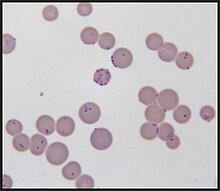Mycoplasma (plural mycoplasmas or mycoplasmata) is a genus of bacteria that lack a cell wall around their cell membranes.[1] This characteristic makes them naturally resistant to antibiotics that target cell wall synthesis (like the beta-lactam antibiotics). They can be parasitic or saprotrophic. Several species are pathogenic in humans, including M. pneumoniae, which is an important cause of "walking" pneumonia and other respiratory disorders, and M. genitalium, which is believed to be involved in pelvic inflammatory diseases. Mycoplasma species are the smallest bacterial cells yet discovered,[2] can survive without oxygen, and come in various shapes. For example, M. genitalium is flask-shaped (about 300 x 600 nm), while M. pneumoniae is more elongated (about 100 x 1000 nm). Hundreds of mycoplasma species infect animals.[3]
| Mycoplasma | |
|---|---|
 | |
| Mycoplasma haemofelis | |
| Scientific classification | |
| Domain: | Bacteria |
| Phylum: | Tenericutes |
| Class: | Mollicutes |
| Order: | Mycoplasmatales |
| Family: | Mycoplasmataceae |
| Genus: | Mycoplasma J.Nowak 1929 |
https://en.wikipedia.org/wiki/Mycoplasma
Above.
No comments:
Post a Comment